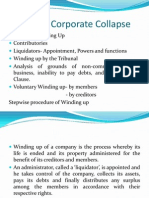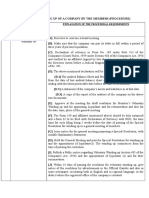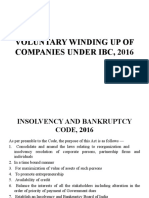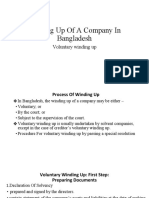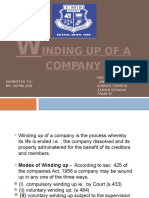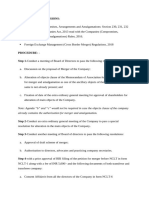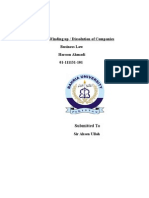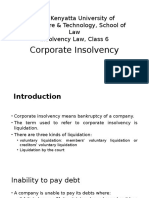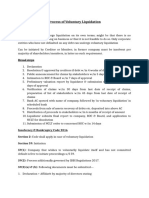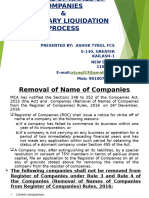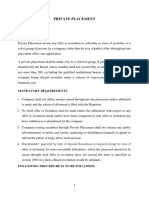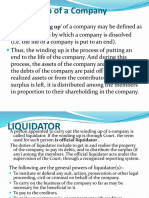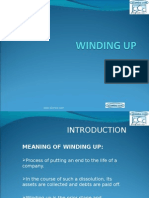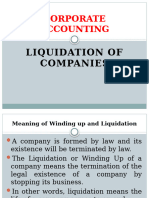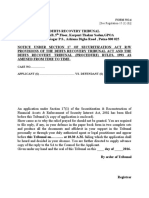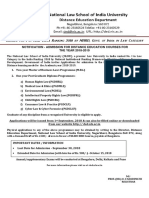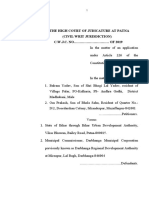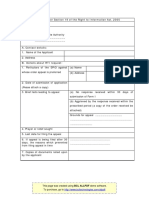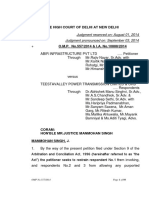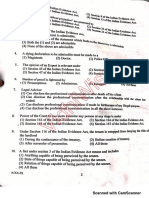Steps of VWU
Steps of VWU
Uploaded by
Manini JaiswalCopyright:
Available Formats
Steps of VWU
Steps of VWU
Uploaded by
Manini JaiswalOriginal Description:
Copyright
Available Formats
Share this document
Did you find this document useful?
Is this content inappropriate?
Copyright:
Available Formats
Steps of VWU
Steps of VWU
Uploaded by
Manini JaiswalCopyright:
Available Formats
Powers of Official Liquidator 1.
In voluntary winding up of company Voluntary liquidator may exercise the following powers with the sanction of special resolution in the case of members voluntary winding up; - with the sanction of court or committee of inspection in the case of creditors voluntary winding up; - with the sanction of creditors if there is no such committee:
to institute and defend any suit, prosecution or other legal proceeding, civil or criminal, in the name and on behalf of the company to carry on the business of the company; to sell the immovable and movable property and actionable claims of the company by public auction or private contract to raise on the security of assets of the company any money requisite.
PROCEDURE TO PUT A COMPANY INTO MEMBERS VOLUNTARY WINDING UP.
STEP 1: Convene a Board Meeting to transact the following business: (a) Make sure that the company can pay its debts in full within a period of three years if put into liquidation. (b) Declaration in Form No. 149 under Rule 313 of the Companies (Court) Rules, 1959, and verified by an affidavit, by the Directors sworn before a Judicial Magistrate on non-judicial stamp paper of Rs. 20/-. (c) Declaration will be accompanied by: i) The audited
Balance Sheet and Profit & Loss Account commencing from the date of last audited balance sheet and profit and loss account and ending with the latest practicable date before the date of declaration. ii) A statement of the companys assets and liabilities as at that date; and iii) A copy of the report of the auditors of the company on the above two documents. (d) Approve at the meeting the draft resolution for Members Voluntary Winding up and for appointing Liquidator and fix remuneration and also fix the date, time, place of the general meeting.
STEP 2: Copies of item (b) and (c) to be filed and registered with the Registrar at least 5 weeks before the General Meeting. STEP 3: Issue notice for the general meeting proposing a Special Resolution, with suitable Explanatory Statement. STEP 4: Hold the General Meeting and pass the Special Resolution for winding up. The winding up commences from the time of passing the resolution.
STEP 5: Within ten days of passing of the resolution, file notice with the ROC for the appointment of the liquidator after paying the requisite fee. STEP 6: Submit to the liquidator a statement on the companys affairs in Form No.57 in duplicate, duly verified by affidavit in Form No. 58 within twenty-one days of the commencement of winding up. STEP 7: File the Special Resolution passed for winding up with Explanatory statement with the ROC within 30 days of its passing in Form No .23 with requisite fee.
STEP 8: Within 14 days of passing the resolution for voluntary winding up, give notice of the resolution by advertisement in the Official Gazette and also in some newspaper circulating both in English and in Tamil, in the district where the registered office of the company is situated. STEP 9: Simultaneously to Step 8, the Liquidator to publish in the Official Gazette the Notice of his appointment in Form No. 151 of Company Court Rules and file with Registrar the Notice of his Appointment in form 152 of Company Court Rules.
STEP 10: Simultaneously to Step 8, Liquidator to give notice of his appointment to the concerned Income-tax Officer under Section 178 of IT Act, 1961. No prescribed format for this intimation. Letter would be sufficient. STEP 11: If the liquidator is of the opinion that the company will not be able to pay its debts in full within the period stated in the declaration of solvency, or if the period stated in the declaration of solvency has
expired without the debts being paid in full, the liquidator has to summon a meeting of the creditors, and table before the meeting a statement of the assets and liabilities of the company in Form No. 150 of the Companies (Court) Rules, 1959. STEP 12: Where the winding up process continues for more then a year, Liquidator should call a general meeting within 3 month from the end of every year from the date of commencement of winding up, and table before the meeting an account of his acts and dealings along with statement in form No 153 of the
Companies (Court) Rules, which should be duly verified in Form 154 of the Company Court Rules. STEP 13: If Step 11 is applicable, the Liquidator to call a meeting of creditors also within 3 months from the end of the year. STEP 14: The Liquidator to file statements in the prescribed manner together with the Audit Report in the prescribed format, with the concerned Registrar of Companies twice in every year, if the liquidation is NOT completed within one year from the commencement of the winding up.
STEP 15: Complete the winding up by realising all assets and paying off all liabilities and returning share capital and surplus, if any. The provisions of sections 426, to 432, 487, 491, 494, 511, 511A, 512, 517 to 520, 528 to 549 and 553 and those of rules from Nos. 124 to 134 and Nos: 312 to 361 of the Companies (Court) Rules 1959 should also be noted in this respect. STEP 16: As soon as the affairs of the company are fully wound-up, liquidator to prepare his account of the winding up in Form No. 156 of the Companies (Court) Rules 1959 and get the same audited. The audit report should be in the format suggested by ICAI for this purpose.
STEP 17: Liquidator to call the final General Meeting by giving notice stating the time, place and object of the meeting, in Form No. 155 of the Companies (Court) Rules, 1959 by advertisement in the official Gazette. The Notice in the Gazette to be given not less than one month before the meeting. In addition, the notice should also be published in some newspaper circulating in the district where the registered office of the company is situated.
STEP 18: At the meeting, place the accounts prepared under Step 16. STEP 19: At the meeting also pass a special resolution for disposal of the books and papers of the company when the affairs of the company are completely wound up and it is about to be dissolved. STEP 20: Within a week of the final meeting held under Step 17, file the copy of the account with the ROC as well as with the Official Liquidator (OL) and also file a return with both in Form No. 157 of the Companies (Court) Rules 1959. If a quorum is not
present at the meeting, file the return in form no. 158 of the Companies (Court) Rules, 1959. STEP 21: File the Special Resolution with the ROC, within 30 days of passing in Form No. 23 after paying the requisite fee.
SUBSEQUENT COURSE OF ACTION FROM THE ROC AND OL
1. The Registrar of Companies, on receiving the account and the return shall forthwith register them. 2. The OL on receiving the account and the return would make a scrutiny of the books and papers of the Company to ascertain as to whether the affairs of the Company has not been carried on in a manner prejudicial to the interest of its members or public, and makes a report to the concerned High Court. From the date of the submission of the report to the concerned High Court the company is deemed to be dissolved
You might also like
- Company LiquidationDocument9 pagesCompany LiquidationcarltawiaNo ratings yet
- VakalatnamaDocument1 pageVakalatnamaManini Jaiswal100% (2)
- Members Voluntary Winding UpDocument3 pagesMembers Voluntary Winding Updineshgupta007No ratings yet
- Module-II Corporate CollapseDocument59 pagesModule-II Corporate CollapseManini JaiswalNo ratings yet
- Voluntary Winding Up of A Company by The Members of The CompanyDocument4 pagesVoluntary Winding Up of A Company by The Members of The CompanySahilBansalNo ratings yet
- The Insolvency and Bankruptcy Code (AMENDMENT) ACT, 2017Document21 pagesThe Insolvency and Bankruptcy Code (AMENDMENT) ACT, 2017Vinay PrakashNo ratings yet
- Company Winding UpDocument7 pagesCompany Winding UpNimur RahamanNo ratings yet
- Voluntary Winding Up of Companies Under IbcDocument16 pagesVoluntary Winding Up of Companies Under IbcSher Singh YadavNo ratings yet
- Process of Voluntary Liquidation of A CompanyDocument7 pagesProcess of Voluntary Liquidation of A CompanyNeelotpala AlapatiNo ratings yet
- Procedure For Winding Up of Company-1 2Document4 pagesProcedure For Winding Up of Company-1 2Umang KatochNo ratings yet
- Voluntary Winding Up by Members - Voluntary Winding Up by CreditorsDocument12 pagesVoluntary Winding Up by Members - Voluntary Winding Up by CreditorsAsal QasimNo ratings yet
- Winding Up of A Company inDocument13 pagesWinding Up of A Company inMohammad Aminul Islam rubelNo ratings yet
- Company Law - Ii Assingment Winding Up of A Company Under Ibc Act, 2016Document6 pagesCompany Law - Ii Assingment Winding Up of A Company Under Ibc Act, 2016priyanka_kajlaNo ratings yet
- InsolvencyDocument28 pagesInsolvencykerriemelissa5No ratings yet
- 1.ultra Vires: Rs Into Acontract That Is Beyond The Scope of Its Corporate Powers, The Contract Is IllegalDocument3 pages1.ultra Vires: Rs Into Acontract That Is Beyond The Scope of Its Corporate Powers, The Contract Is IllegalARJUN VNo ratings yet
- Legal Environment and BusinessDocument25 pagesLegal Environment and BusinessZshan FarazNo ratings yet
- Steps To Be Followed by Transferee CompanyDocument4 pagesSteps To Be Followed by Transferee CompanyKartik ThakkarNo ratings yet
- Winding Up of A CompanyDocument22 pagesWinding Up of A CompanyAnant GargNo ratings yet
- Inding Up of A CompanyDocument22 pagesInding Up of A CompanySonu RaniNo ratings yet
- Voluntary Winding UpDocument4 pagesVoluntary Winding UpAyushi AgarwalNo ratings yet
- Add Sbec 22Document10 pagesAdd Sbec 22hiteshchhangani1207No ratings yet
- Dissolution of A CorporationDocument8 pagesDissolution of A Corporationggsteph100% (1)
- Steps For Voluntary Winding Up of A CompanyDocument2 pagesSteps For Voluntary Winding Up of A CompanyPurvi ShahNo ratings yet
- Winding Up of CompaniesDocument23 pagesWinding Up of CompaniesAkash GoyalNo ratings yet
- Winding Up of CompaniesDocument25 pagesWinding Up of CompaniesVikash BhattNo ratings yet
- Introduction of Companies Act 1994Document16 pagesIntroduction of Companies Act 1994Imran HasanNo ratings yet
- Procedure of Inbound MergerDocument4 pagesProcedure of Inbound Mergertripijoshi73No ratings yet
- MANUAL PROCEDURE For COMPANY REGISTRATIONDocument4 pagesMANUAL PROCEDURE For COMPANY REGISTRATIONHamza ElahiNo ratings yet
- Winding Up of The Company by The CourtDocument5 pagesWinding Up of The Company by The CourtSaad SolangiNo ratings yet
- Winding Up AssignmentDocument4 pagesWinding Up AssignmentHaroonĦammadiNo ratings yet
- Module-4 Winding UpDocument3 pagesModule-4 Winding Uphozaifa ajazNo ratings yet
- Conversion of Entities-2Document13 pagesConversion of Entities-2booksbrakerNo ratings yet
- Alteration of Share Capital (Listed Co)Document21 pagesAlteration of Share Capital (Listed Co)Babyzz ShafikahNo ratings yet
- Class 7 - Corporate InsolvencyDocument18 pagesClass 7 - Corporate InsolvencyDickson Tk Chuma Jr.No ratings yet
- Winding UpDocument3 pagesWinding UpMahnaz AnsariNo ratings yet
- Mergers and AmalgamationDocument14 pagesMergers and AmalgamationRohan VijayNo ratings yet
- Lesson 8 Voluntary Liquidation of CompaniesDocument7 pagesLesson 8 Voluntary Liquidation of CompaniesShiv ShankarNo ratings yet
- Voluntary Winding UpDocument2 pagesVoluntary Winding UpAbhishekBoobNo ratings yet
- Procedure To Covert An Educational Institution To A Section 8 CompanyDocument2 pagesProcedure To Covert An Educational Institution To A Section 8 CompanyKushal KotamrajuNo ratings yet
- Company Law AssignmentDocument10 pagesCompany Law Assignmentdeepthiseran25598No ratings yet
- Voluntary LiquidationDocument4 pagesVoluntary LiquidationArchisha DharNo ratings yet
- Winding Up of CompaniesDocument28 pagesWinding Up of CompaniesKarthikeyanNo ratings yet
- Winding Up of CompaniesDocument23 pagesWinding Up of CompaniesBindu MalviyaNo ratings yet
- 2 - Ghana Act 180Document27 pages2 - Ghana Act 180jordanparish425No ratings yet
- Authentication of Documents 2 - Statutory Books 3-Filing of Statutory ReturnsDocument35 pagesAuthentication of Documents 2 - Statutory Books 3-Filing of Statutory ReturnsroshniNo ratings yet
- Capital Reduction Process and QuestionsDocument8 pagesCapital Reduction Process and QuestionsShital Darak MandhanaNo ratings yet
- FinanceDocument6 pagesFinanceIan JoveroNo ratings yet
- Voluntary Winding Up and Removal of NamesDocument21 pagesVoluntary Winding Up and Removal of Namespratistha.priyadarshiNo ratings yet
- Private Placement (Preferential Allotment and Qualified Institutional Placement) PDFDocument10 pagesPrivate Placement (Preferential Allotment and Qualified Institutional Placement) PDFyesetNo ratings yet
- Winding Up of A Company Is The StageDocument8 pagesWinding Up of A Company Is The StageroutraykhushbooNo ratings yet
- Company Law Lec 3Document16 pagesCompany Law Lec 3Arif.hossen 30No ratings yet
- Procedure For Voluntary WindingDocument1 pageProcedure For Voluntary WindingIrene GohNo ratings yet
- Winding UpDocument17 pagesWinding Upritesh85No ratings yet
- 7 CLSP Shares, Debentures and AllotmentDocument21 pages7 CLSP Shares, Debentures and AllotmentSyed Mujtaba HassanNo ratings yet
- Buy-Back Process Under Companies Act & RulesDocument8 pagesBuy-Back Process Under Companies Act & Rulesdevendra bankarNo ratings yet
- BCOM 204 Advance AccountingDocument269 pagesBCOM 204 Advance AccountingMelody Aludo Borja AgravanteNo ratings yet
- Liquidation of CompaniesDocument29 pagesLiquidation of CompaniesNikita BedareNo ratings yet
- Declaration of DividendsDocument3 pagesDeclaration of DividendsAnubha DwivediNo ratings yet
- Bar Review Companion: Taxation: Anvil Law Books Series, #4From EverandBar Review Companion: Taxation: Anvil Law Books Series, #4No ratings yet
- 1040 Exam Prep Module III: Items Excluded from Gross IncomeFrom Everand1040 Exam Prep Module III: Items Excluded from Gross IncomeRating: 1 out of 5 stars1/5 (1)
- MTUjMTMzMTkjMjAyMyMyI04 uDgMEBskEGkDocument10 pagesMTUjMTMzMTkjMjAyMyMyI04 uDgMEBskEGkManini JaiswalNo ratings yet
- PersonalDocument13 pagesPersonalManini JaiswalNo ratings yet
- Form No.4: (See Regulation-15 (1) (B) )Document1 pageForm No.4: (See Regulation-15 (1) (B) )Manini JaiswalNo ratings yet
- Form No.4: (See Regulation-15 (1) (B) )Document1 pageForm No.4: (See Regulation-15 (1) (B) )Manini JaiswalNo ratings yet
- Form No 15Document1 pageForm No 15Manini JaiswalNo ratings yet
- SKS InterestDocument1 pageSKS InterestManini JaiswalNo ratings yet
- Banking Ombusman - (Consume Affairs)Document8 pagesBanking Ombusman - (Consume Affairs)Manini JaiswalNo ratings yet
- DRT Form 3Document2 pagesDRT Form 3Manini JaiswalNo ratings yet
- Admissions Notification Application 2018 19 PDFDocument5 pagesAdmissions Notification Application 2018 19 PDFManini JaiswalNo ratings yet
- In The High Court of Judicature at Patna (Civil Writ Jurisdiction) C.W.J.C. NO OF 2019Document7 pagesIn The High Court of Judicature at Patna (Civil Writ Jurisdiction) C.W.J.C. NO OF 2019Manini JaiswalNo ratings yet
- Form Rti First For AppealDocument1 pageForm Rti First For AppealManini JaiswalNo ratings yet
- Abir Infra vs. Teesta ValleyDocument98 pagesAbir Infra vs. Teesta ValleyManini JaiswalNo ratings yet
- Djs Pre Exam 2019Document30 pagesDjs Pre Exam 2019Manini JaiswalNo ratings yet
- AffidavitDocument1 pageAffidavitManini JaiswalNo ratings yet
- NoticeDocument1 pageNoticeManini JaiswalNo ratings yet
- Display PDFDocument42 pagesDisplay PDFManini JaiswalNo ratings yet



